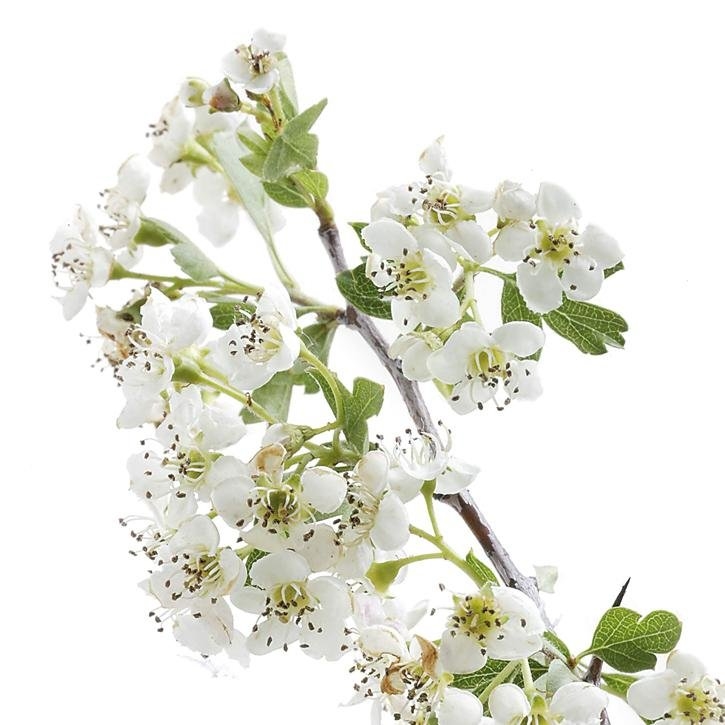Description
Hawthorn usually forms highly branched, low high shrubs, between 2-5 m high and they can reach sometimes even 10 m. The branching is very dense and tangled and presents prickly branches with dark brown, woody stems from 1 mm to 2.5 mm in diameter. Oval or rhombic, simple, petiolate, alternate leaves with well-developed petiole, often with small deciduous stipules, slightly serrate or nearly entire edges, tapering wedge-shaped at the base. Its flowers are white, small, scented, pedunculated, epigynous, arranged in wide corymbose inflorescences. Flowering usually occurs in spring, from April to May. The fruits, called hawthorns are globose or ovoid, red colored, pea-sized (5-10 mm) or a little thicker, with persistent sepals in the apex. It has a sweet or insipid taste, contains a single seed. They mature in September-October, sometimes in August. It belongs to the Rosaceae family.
Plant coming from the center of Europe, North Africa, North America and western Asia. It is abundant in many species in the Himalayas and in Europe, it spreads out to France and the center and south of UK without reaching the northern colder areas. It can be found in the wild state in forest edges, on the sunny slopes and widely cultivated to form impenetrable hedges in gardens or hedges dividing the fields or to keep inside the cattle. It hasn’t marked preference for any type of ground, but it grows better in loose and fresh grounds. As for the climate, it puts up with both the cold and the warm, but it is better the sun for it. It puts up with the partial shade. It is very suitable for mountain gardens and also for urban conditions.
Part used
The parts of the plant that are more frequently used are its flowering tops. Also, the leaves, fruits and sometimes the bark can be used.
Indications
Internal use
- Cardiac deficiency.
- Coronary deficiency- prevention and recovery of myocardial infarction, angina pectoris. It is not useful in acute processes since its effect develops slowly.
- Cardiac rhythm disorders: paroxistic tachycardia, arrhythmias, extrasystole.
- Cardiac disorders of nervous origin- palpitations, anginal pains, etc.
- Arterial hypertension.
- Prevention and treatment of the arteriosclerosis.
- Neurovegetative dystonia, vascular spasms, vertigo.
- Nervousness, nervous excitement, anxiety, stress.
- Insomnia or slight sleep disorders.
- Hawthorn offers some important advantages over certain conventional drugs used to treat congestive heart failure such as digoxin.
External use
- Acneic, couperose and sensitive skin.
Bibliography
PDR for Herbal Medicines. Medical Economics Company, Montvale. Second Edition, 2000; pp 271-5
Blumenthal M, Goldberg A, Brinckmann J. Herbal Medicine, Expanded Commission E Monographs. Integrative Medicine Communications, Newton. First Edition, 2000; pp 182-92.
Carreretero E. Compuestos fenólicos: flavonoides. Panorama Actual Med 2000; 24(234):525-8
Plantas Medicinales. Thérapeutique-Toxicité. Christiane Vigneau. Masson, Paris 1985.
Herbal Drugs and Phytopharmaceuticals. Norman Grainger Bisset (Ed). Max Wichtl. CRC Press.1994.
Plantas Medicinales y Drogas Vegetales para infusión y tisana. Edición española a cargo de: Salvador Cañigueral, Roser Vila, Max Wichtl.1998.
Plantas Medicinales. Margarita Fernandez y Ana Nieto. Ed Universidad de Navarra. EUNSA 1982.
100 Plantes Medicinales. Max Rombi. Romart 1998.
Pharmacognosy, Phytochemistry, Medicinal Plants. Jean Bruneton. Lavoisier Publishing.
Fitoterapia Aplicada. J.B. Peris, G. Stübing, B.Vanaclocha. Colegio Oficial de Farmacéuticos de Valencia 1995.
Fitoterapia: Vademecum de Prescripción. Plantas Medicinales. Colaboran: Asociación española de médicos naturistas. Colegio Oficial de Farmacéuticos de Vizcaya.
Plantas Medicinales. El Dioscórides Renovado.Pio Font Quer.
Plantes Médicinales des régions tempérees.L. Bézanger-Beauquesne et M. Pinkas. M. Torch et F.Trotin. Maloine S.A. Editeur. Paris 1980.
